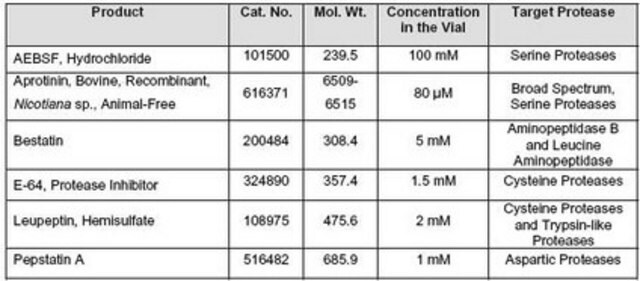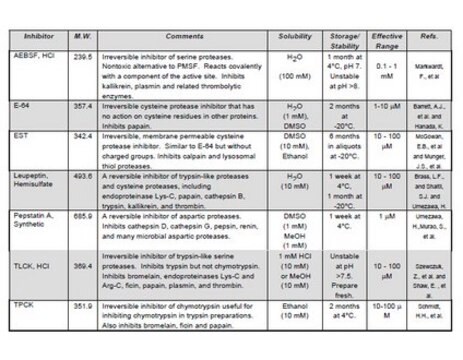539137
Protease Inhibitor Cocktail V
EDTA-Free, lyophilized, A cocktail of four protease inhibitors for the inhibition of serine, cysteine, but not metalloproteases.
Sinónimos:
EDTA free Protease inhibitor
About This Item
Productos recomendados
Nombre del producto
Protease Inhibitor Cocktail Set V, EDTA-Free, A cocktail of four protease inhibitors for the inhibition of serine, cysteine, but not metalloproteases.
Nivel de calidad
Formulario
lyophilized
fabricante / nombre comercial
Calbiochem®
condiciones de almacenamiento
OK to freeze
desiccated (hygroscopic)
solubilidad
water: soluble
Condiciones de envío
wet ice
temp. de almacenamiento
−20°C
Descripción general
Especificidad
Acciones bioquímicas o fisiológicas
Serine and cysteine proteases, but not metalloproteases
Advertencia
Reconstitución
Información legal
Palabra de señalización
Danger
Frases de peligro
Consejos de prudencia
Clasificaciones de peligro
Eye Dam. 1 - Skin Corr. 1A
Código de clase de almacenamiento
8A - Combustible corrosive hazardous materials
Clase de riesgo para el agua (WGK)
WGK 3
Certificados de análisis (COA)
Busque Certificados de análisis (COA) introduciendo el número de lote del producto. Los números de lote se encuentran en la etiqueta del producto después de las palabras «Lot» o «Batch»
¿Ya tiene este producto?
Encuentre la documentación para los productos que ha comprado recientemente en la Biblioteca de documentos.
Los clientes también vieron
Nuestro equipo de científicos tiene experiencia en todas las áreas de investigación: Ciencias de la vida, Ciencia de los materiales, Síntesis química, Cromatografía, Analítica y muchas otras.
Póngase en contacto con el Servicio técnico
















